2010 SKODA OCTAVIA TOUR maintenance
[x] Cancel search: maintenancePage 95 of 199
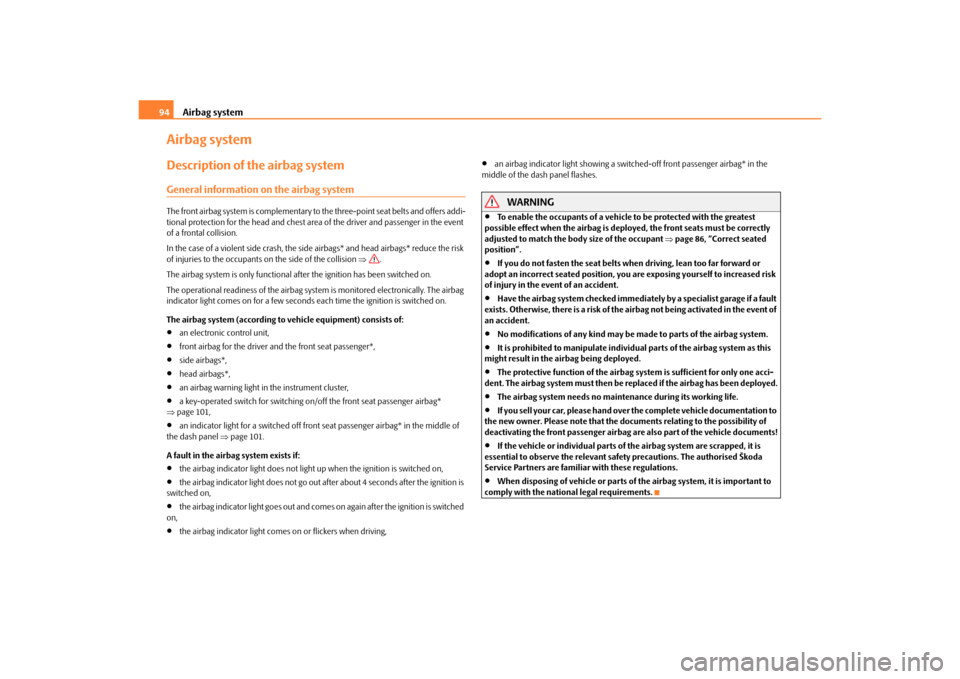
Airbag system
94
Airbag systemDescription of the airbag systemGeneral information on the airbag systemThe front airbag system is complementary to the three-point seat belts and offers addi-
tional protection for the head and chest area of the driver and passenger in the event
of a frontal collision.
In the case of a violent side crash, the side airbags* and head airbags* reduce the risk
of injuries to the occupants on the side of the collision .
The airbag system is only functional af ter the ignition has been switched on.
The operational readiness of the airbag syst em is monitored electronically. The airbag
indicator light comes on for a few seconds each time the ignition is switched on.
The airbag system (according to vehicle equipment) consists of:
an electronic control unit,
front airbag for the driver and the front seat passenger*,
side airbags*,
head airbags*,
an airbag warning light in the instrument cluster,
a key-operated switch for switching on /off the front seat passenger airbag*
page 101,
an indicator light for a switched off fron t seat passenger airbag* in the middle of
the dash panel page 101.
A fault in the airbag system exists if:
the airbag indicator light does not light up when the ignition is switched on,
the airbag indicator light does not go out after about 4 seconds after the ignition is
switched on,
the airbag indicator light goes out and come s on again after the ignition is switched
on,
the airbag indicator light comes on or flickers when driving,
an airbag indicator light showing a switched-off front passenger airbag* in the
middle of the dash panel flashes.
WARNING
To enable the occupants of a vehicle to be protected with the greatest
possible effect when the airbag is depl oyed, the front seats must be correctly
adjusted to match the body size of the occupant page 86, “Correct seated
position”.
If you do not fasten the seat belts when driving, lean too far forward or
adopt an incorrect seated position, you are exposing yourself to increased risk
of injury in the event of an accident.
Have the airbag system checked immediat ely by a specialist garage if a fault
exists. Otherwise, there is a risk of the airbag not being activated in the event of
an accident.
No modifications of any kind may be made to parts of the airbag system.
It is prohibited to manipulate individual parts of the airbag system as this
might result in the airbag being deployed.
The protective function of the airbag system is sufficient for only one acci-
dent. The airbag system must then be re placed if the airbag has been deployed.
The airbag system needs no maintenance during its working life.
If you sell your car, please hand over the complete vehicle documentation to
the new owner. Please note that the documents relating to the possibility of
deactivating the front passenger airbag are also part of the vehicle documents!
If the vehicle or individual parts of the airbag system are scrapped, it is
essential to observe the relevant safety precautions. The authorised Škoda
Service Partners are familiar with these regulations.
When disposing of vehicle or parts of the airbag system, it is important to
comply with the national legal requirements.
s2bs.2.book Page 94 Monday, September 27, 2010 9:53 AM
Page 96 of 199

Airbag system95
Using the system
Safety
Driving Tips
General Maintenance
Breakdown assistance
Technical Data
When are the airbags deployed?The airbag system is designed in such a wa y that the driver and front passenger airbag
are deployed in the event of a violent frontal collision.
In the case of a violent side collision , the side airbag* on the side of the vehicle at
which the collision occurs, is deployed to gether with the relevant head airbag*.
In special accident scenarios, the front as well as the relevant side and head airbags
may be deployed together.
The airbags are not deployed in the case of minor frontal and side collisions, in the
case of rear-end collisi ons and vehicle rollover.
Deployment factors
It is not possible to state globally which deployment conditions apply to the airbag
system in every situation as the circumstances which exist in the case of accidents vary
greatly. An important role in this case is played by factors such as the type of object
against which the vehicle impacts (hard, soft ), the angle of impact, the relative speed
during the accident etc.
A decisive factor for the deployment of the airbags is the deceleration which occurs
during a collision. The control unit analyses the nature of the collision and activates the
relevant restraint system. If the vehicle deceleration which occurs and is measured
during the collision remains below the prescribed reference values specified in the
control unit, the airbags are no t deployed although the vehicle may well suffer severe
damage to the bodywork as a consequence of the accident.
The airbags are not deployed if:
ignition off,
a minor frontal collision,
a minor side collision,
a rear-end collision,
Rollover of the vehicle.Note
A grey white, non harmful gas is released when airbag is inflated. This is perfectly
normal and is not an indicati on of a fire in the vehicle.
In the event of an accident in which the airbags are deployed:
The interior lighting comes on (if the switch for the interior light is in the door
contact position),
The hazard warning light is switched on,
All the doors are unlocked,
the fuel supply to the engine is interrupted.
Front airbagsDescription of the front airbags
The airbag system is not a su bstitute for the seat belt!Fig. 95 Driver airbag in the steering whee l/front passenger airbag in the dash panelThe front airbag for the driver is housed in the steering wheel fig. 95 - left. The front
airbag for the front passenger* is housed in the dash panel above the storage compart-
ment fig. 95 - right. The installation positions are each marked with the “AIRBAG”
logo.
The front airbag system is complementary to the three-point seat belts and offers addi-
tional protection for the head and chest area of the driver and passenger in the event
of a frontal collision. page 96
The airbag is not a substitute for the seat belt, but is part of the complete passive
vehicle safety concept. Please note that an airbag can only offer you optimal
protection in combination with a seat belt which is fastened .
s2bs.2.book Page 95 Monday, September 27, 2010 9:53 AM
Page 98 of 199
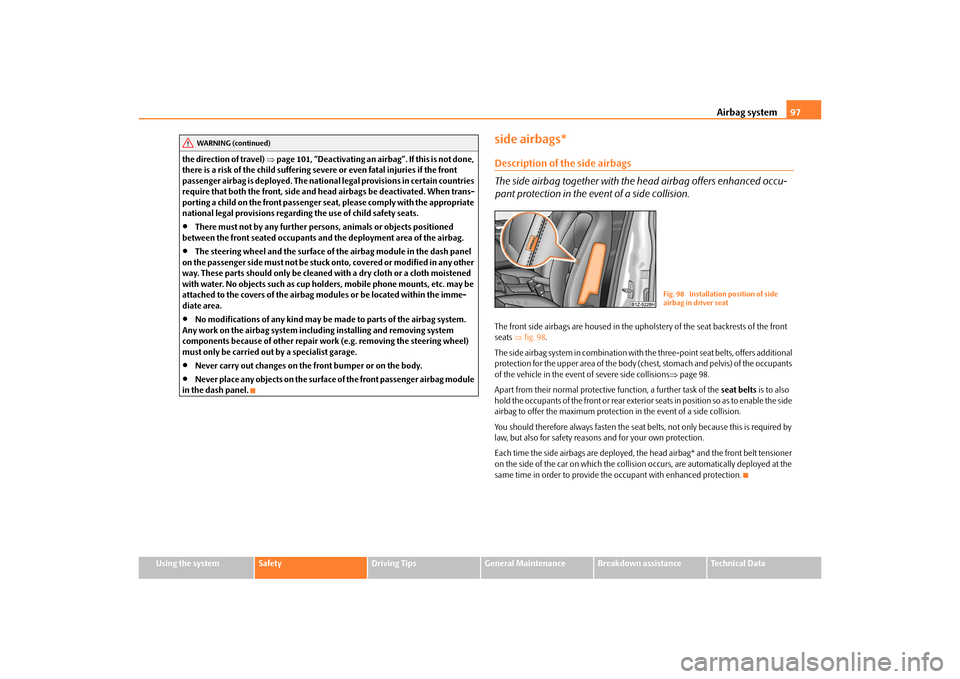
Airbag system97
Using the system
Safety
Driving Tips
General Maintenance
Breakdown assistance
Technical Data
the direction of travel)
page 101, “Deactivating an airbag”. If this is not done,
there is a risk of the child suffering seve re or even fatal injuries if the front
passenger airbag is deployed. The national legal provisions in certain countries
require that both the front, side and head airbags be deactivated. When trans-
porting a child on the front passenger se at, please comply with the appropriate
national legal provisions regarding the use of child safety seats.
There must not by any further persons, animals or objects positioned
between the front seated occupants and the deployment area of the airbag.
The steering wheel and the surface of the airbag module in the dash panel
on the passenger side must not be stuck onto, covered or modified in any other
way. These parts should only be cleaned with a dry cloth or a cloth moistened
with water. No objects such as cup holders, mobile phone mounts, etc. may be
attached to the covers of the airbag modules or be located within the imme-
diate area.
No modifications of any kind may be made to parts of the airbag system.
Any work on the airbag system includ ing installing and removing system
components because of other repair wo rk (e.g. removing the steering wheel)
must only be carried out by a specialist garage.
Never carry out changes on the front bumper or on the body.
Never place any objects on the surface of the front passenger airbag module
in the dash panel.
side airbags*Description of the side airbags
The side airbag together with the head airbag offers enhanced occu-
pant protection in the event of a side collision.The front side airbags are housed in the upholstery of the seat backrests of the front
seats fig. 98 .
The side airbag system in combination with the three-point seat belts, offers additional
protection for the upper area of the body (chest, stomach and pelvis) of the occupants
of the vehicle in the event of severe side collisions page 98.
Apart from their normal protective function, a further task of the seat belts is to also
hold the occupants of the front or rear exterior seats in position so as to enable the side
airbag to offer the maximum protection in the event of a side collision.
You should therefore always fasten the seat belts, not only because this is required by
law, but also for safety reasons and for your own protection.
Each time the side airbags are deployed, th e head airbag* and the front belt tensioner
on the side of the car on which the collision occurs, are automatically deployed at the
same time in order to provide the occupant with enhanced protection.
WARNING (continued)
Fig. 98 Installation position of side
airbag in driver seat
s2bs.2.book Page 97 Monday, September 27, 2010 9:53 AM
Page 100 of 199
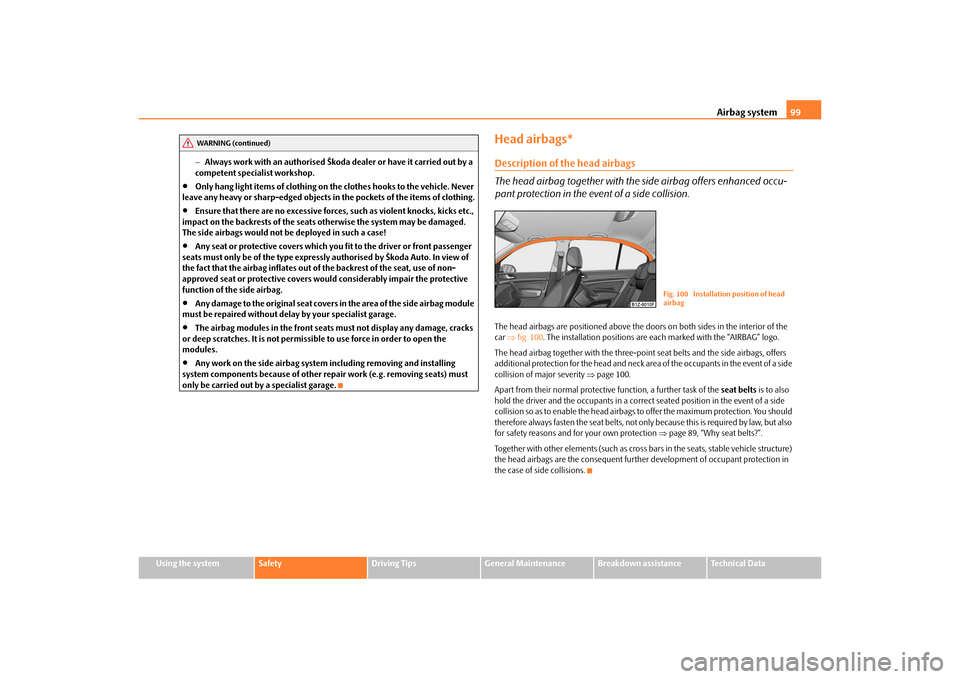
Airbag system99
Using the system
Safety
Driving Tips
General Maintenance
Breakdown assistance
Technical Data
Always work with an authorised Škoda dealer or have it carried out by a
competent specialist workshop.
Only hang light items of clothing on the clothes hooks to the vehicle. Never
leave any heavy or sharp-edged objects in the pockets of the items of clothing.
Ensure that there are no excessive forc es, such as violent knocks, kicks etc.,
impact on the backrests of the seats otherwise the system may be damaged.
The side airbags would not be deployed in such a case!
Any seat or protective covers which you fit to the driver or front passenger
seats must only be of the type expressly authorised by Škoda Auto. In view of
the fact that the airbag inflates out of the backrest of the seat, use of non-
approved seat or protective covers would considerably impair the protective
function of the side airbag.
Any damage to the original seat covers in the area of the side airbag module
must be repaired without dela y by your specialist garage.
The airbag modules in the front seats must not display any damage, cracks
or deep scratches. It is not permissible to use force in order to open the
modules.
Any work on the side airbag system including removing and installing
system components because of other repair work (e.g. removing seats) must
only be carried out by a specialist garage.
Head airbags*Description of the head airbags
The head airbag together with the side airbag offers enhanced occu-
pant protection in the event of a side collision.The head airbags are positioned above the door s on both sides in the interior of the
car fig. 100 . The installation positions are each marked with the “AIRBAG” logo.
The head airbag together with the three-poin t seat belts and the side airbags, offers
additional protection for the head and neck ar ea of the occupants in the event of a side
collision of major severity page 100.
Apart from their normal protective function, a further task of the seat belts is to also
hold the driver and the occupants in a correct seated position in the event of a side
collision so as to enable the head airbags to offer the maximum protection. You should
therefore always fasten the seat belts, not only because this is required by law, but also
for safety reasons and for your own protection page 89, “Why seat belts?”.
Together with other elements (such as cross bars in the seats, stable vehicle structure)
the head airbags are the consequent further development of occupant protection in
the case of side collisions.
WARNING (continued)
Fig. 100 Installation position of head
airbag
s2bs.2.book Page 99 Monday, September 27, 2010 9:53 AM
Page 102 of 199
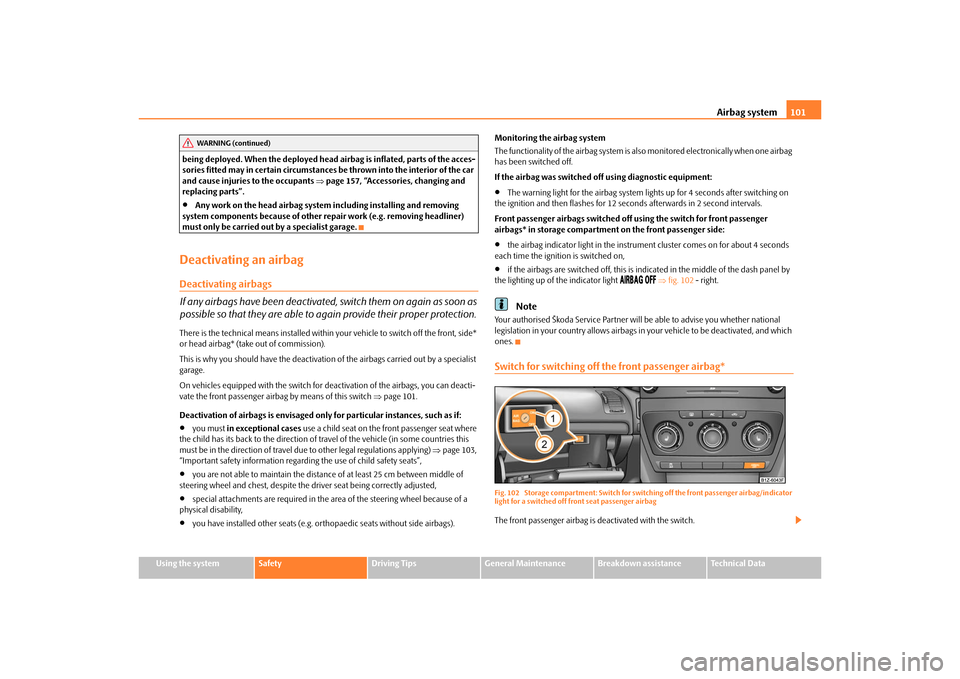
Airbag system101
Using the system
Safety
Driving Tips
General Maintenance
Breakdown assistance
Technical Data
being deployed. When the deployed head airbag is inflated, parts of the acces-
sories fitted may in certain circumstances be thrown into the interior of the car
and cause injuries to the occupants
page 157, “Accessories, changing and
replacing parts”.
Any work on the head airbag system including installing and removing
system components because of other repair work (e.g. removing headliner)
must only be carried out by a specialist garage.
Deactivating an airbagDeactivating airbags
If any airbags have been deactivated, switch them on again as soon as
possible so that they are able to again provide their proper protection.There is the technical means installed within your vehicle to switch off the front, side*
or head airbag* (take out of commission).
This is why you should have the deactivation of the airbags carried out by a specialist
garage.
On vehicles equipped with the switch for de activation of the airbags, you can deacti-
vate the front passenger airbag by means of this switch page 101.
Deactivation of airbags is envisaged only for particular instances, such as if:
you must in exceptional cases use a child seat on the front passenger seat where
the child has its back to the direction of tr avel of the vehicle (in some countries this
must be in the direction of travel due to other legal regulations applying) page 103,
“Important safety information regarding the use of child safety seats”,
you are not able to maintain the distan ce of at least 25 cm between middle of
steering wheel and chest, despite the driver seat being correctly adjusted,
special attachments are required in the ar ea of the steering wheel because of a
physical disability,
you have installed other seats (e.g. orthopaedic seats without side airbags). Monitoring the airbag system
The functionality of the airbag system is al
so monitored electronically when one airbag
has been switched off.
If the airbag was switched off using diagnostic equipment:
The warning light for the airbag system li ghts up for 4 seconds after switching on
the ignition and then flashes for 12 seconds afterwards in 2 second intervals.
Front passenger airbags switched off using the switch for front passenger
airbags* in storage compartmen t on the front passenger side:
the airbag indicator light in the instrume nt cluster comes on for about 4 seconds
each time the igniti on is switched on,
if the airbags are switched off, this is in dicated in the middle of the dash panel by
the lighting up of the indicator light
fig. 102 - right.
Note
Your authorised Škoda Service Partner will be able to advise you whether national
legislation in your country allows airbags in your vehicle to be deactivated, and which
ones.Switch for switching off the front passenger airbag*Fig. 102 Storage compartment: Switch for swit ching off the front passenger airbag/indicator
light for a switched off front seat passenger airbagThe front passenger airbag is deactivated with the switch.
WARNING (continued)
s2bs.2.book Page 101 Monday, September 27, 2010 9:53 AM
Page 104 of 199
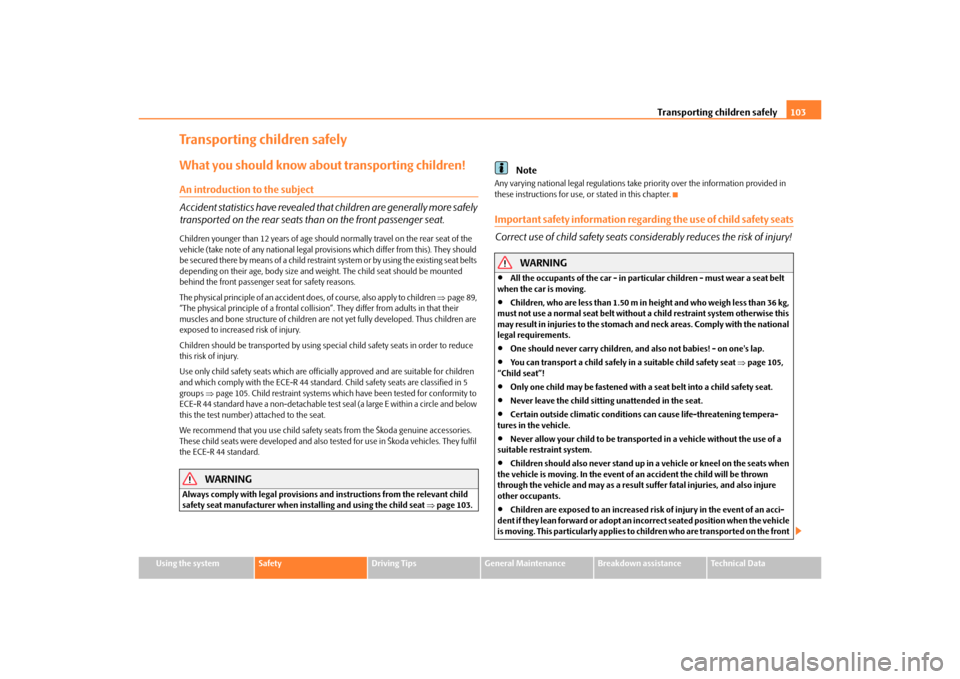
Transporting children safely103
Using the system
Safety
Driving Tips
General Maintenance
Breakdown assistance
Technical Data
Transporting children safelyWhat you should know about transporting children!An introduction to the subject
Accident statistics have revealed that children are generally more safely
transported on the rear seats than on the front passenger seat.Children younger than 12 years of age should normally travel on the rear seat of the
vehicle (take note of any national legal provis ions which differ from this). They should
be secured there by means of a child restraint system or by using the existing seat belts
depending on their age, body size and we ight. The child seat should be mounted
behind the front passenger seat for safety reasons.
The physical principle of an accident does, of course, also apply to children page 89,
“The physical principle of a frontal collision ”. They differ from adults in that their
muscles and bone structure of children are not yet fully developed. Thus children are
exposed to increased risk of injury.
Children should be transporte d by using special child safety seats in order to reduce
this risk of injury.
Use only child safety seats which are officia lly approved and are suitable for children
and which comply with the ECE-R 44 standard. Child safety seats are classified in 5
groups page 105. Child restraint systems which have been tested for conformity to
ECE-R 44 standard have a non-detachable test seal (a large E within a circle and below
this the test number) attached to the seat.
We recommend that you use child safety seats from the Škoda genuine accessories.
These child seats were developed and also tested for use in Škoda vehicles. They fulfil
the ECE-R 44 standard.
WARNING
Always comply with legal provisions and instructions from the relevant child
safety seat manufacturer when inst alling and using the child seat page 103.
Note
Any varying national legal regulations take priority over the information provided in
these instructions for use, or stated in this chapter.Important safety information regarding the use of child safety seats
Correct use of child safety seats cons iderably reduces the risk of injury!
WARNING
All the occupants of the car - in particular children - must wear a seat belt
when the car is moving.
Children, who are less than 1.50 m in height and who weigh less than 36 kg,
must not use a normal seat belt without a child restraint system otherwise this
may result in injuries to the stomach and neck areas. Comply with the national
legal requirements.
One should never carry children, and also not babies! - on one's lap.
You can transport a child safely in a suitable child safety seat page 105,
“Child seat”!
Only one child may be fastened with a seat belt into a child safety seat.
Never leave the child sitting unattended in the seat.
Certain outside climatic conditions can cause life-threatening tempera-
tures in the vehicle.
Never allow your child to be transported in a vehicle without the use of a
suitable restraint system.
Children should also never stand up in a vehicle or kneel on the seats when
the vehicle is moving. In the event of an accident the child will be thrown
through the vehicle and may as a result suffer fatal injuries, and also injure
other occupants.
Children are exposed to an increased risk of injury in the event of an acci-
dent if they lean forward or adopt an in correct seated position when the vehicle
is moving. This particularly applies to children who are transported on the front
s2bs.2.book Page 103 Monday, September 27, 2010 9:53 AM
Page 106 of 199
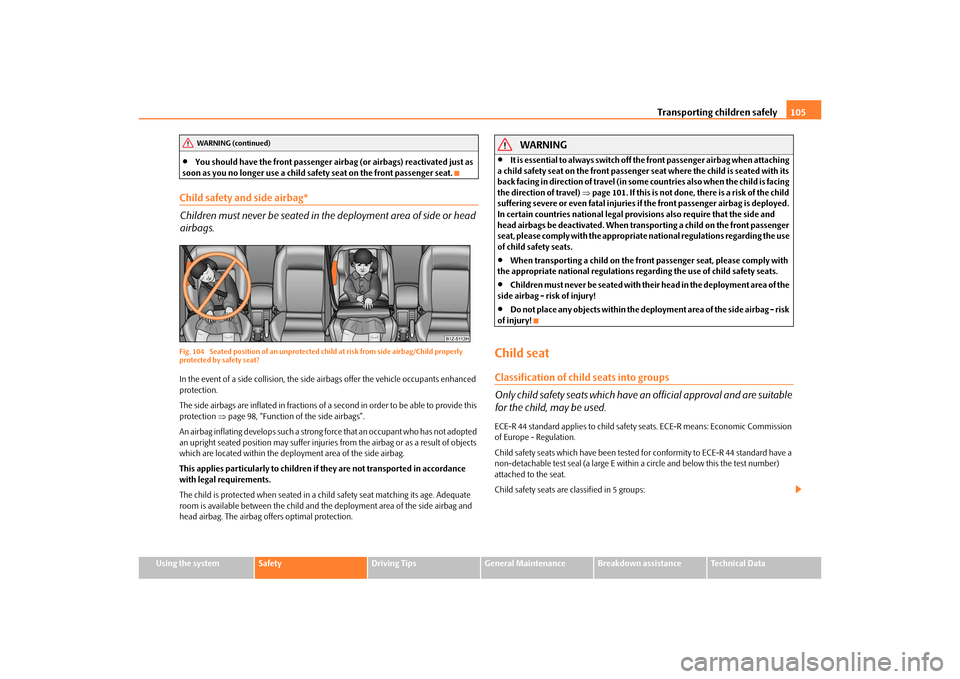
Transporting children safely105
Using the system
Safety
Driving Tips
General Maintenance
Breakdown assistance
Technical Data
You should have the front passenger airbag (or airbags) reactivated just as
soon as you no longer use a child safe ty seat on the front passenger seat.
Child safety and side airbag*
Children must never be seated in the deployment area of side or head
airbags.Fig. 104 Seated position of an unprotected ch ild at risk from side airbag/Child properly
protected by safety seat?In the event of a side collision, the side ai rbags offer the vehicle occupants enhanced
protection.
The side airbags are inflated in fractions of a second in order to be able to provide this
protection page 98, “Function of the side airbags”.
An airbag inflating develops such a strong force that an occupant who has not adopted
an upright seated position may suffer injuries from the airbag or as a result of objects
which are located within the deployment area of the side airbag.
This applies particularly to children if they are not transported in accordance
with legal requirements.
The child is protected when seated in a chil d safety seat matching its age. Adequate
room is available between the child and the deployment area of the side airbag and
head airbag. The airbag offers optimal protection.
WARNING
It is essential to always switch off th e front passenger airbag when attaching
a child safety seat on the front passenger seat where the child is seated with its
back facing in direction of travel (in some countries also when the child is facing
the direction of travel) page 101. If this is not done, there is a risk of the child
suffering severe or even fatal injuries if the front passenger airbag is deployed.
In certain countries national legal provisions also require that the side and
head airbags be deactivated. When transporting a child on the front passenger
seat, please comply with the appropriat e national regulations regarding the use
of child safety seats.
When transporting a child on the front passenger seat, please comply with
the appropriate national regulations r egarding the use of child safety seats.
Children must never be seated with thei r head in the deployment area of the
side airbag - risk of injury!
Do not place any objects within the deployment area of the side airbag - risk
of injury!
Child seatClassification of child seats into groups
Only child safety seats which have an official approval and are suitable
for the child, may be used.ECE-R 44 standard applies to child safety seats. ECE-R means: Economic Commission
of Europe - Regulation.
Child safety seats which have been tested for conformity to ECE-R 44 standard have a
non-detachable test seal (a large E within a circle and below this the test number)
attached to the seat.
Child safety seats are classified in 5 groups:
WARNING (continued)
s2bs.2.book Page 105 Monday, September 27, 2010 9:53 AM
Page 108 of 199
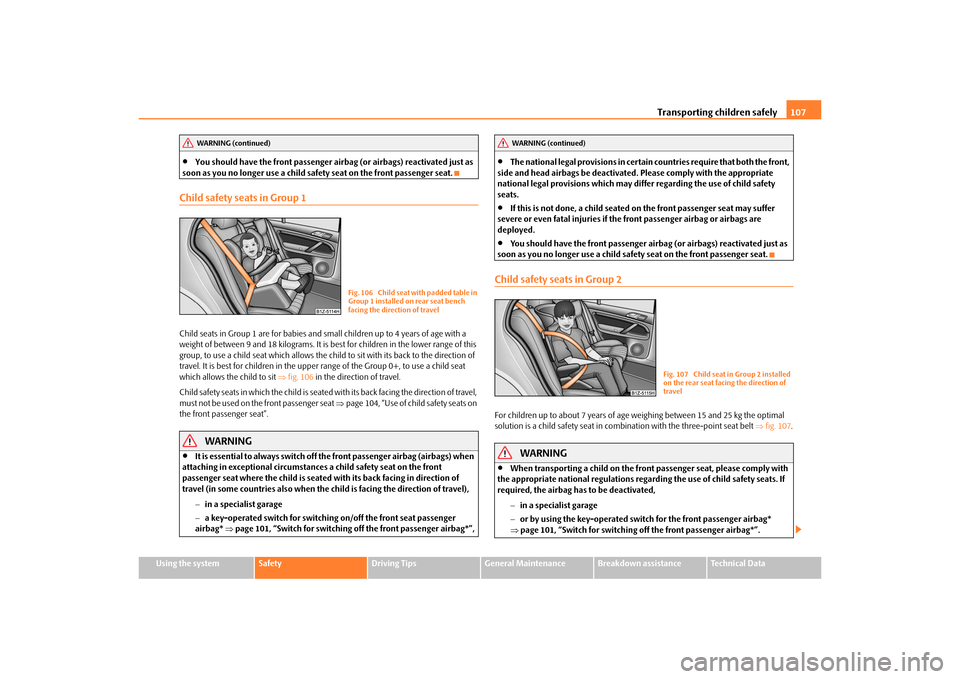
Transporting children safely107
Using the system
Safety
Driving Tips
General Maintenance
Breakdown assistance
Technical Data
You should have the front passenger airbag (or airbags) reactivated just as
soon as you no longer use a child safe ty seat on the front passenger seat.
Child safety seats in Group 1Child seats in Group 1 are for babies and small children up to 4 years of age with a
weight of between 9 and 18 kilograms. It is best for children in the lower range of this
group, to use a child seat which allows the ch ild to sit with its back to the direction of
travel. It is best for children in the uppe r range of the Group 0+, to use a child seat
which allows the child to sit fig. 106 in the direction of travel.
Child safety seats in which the child is seated with its back facing the direction of travel,
must not be used on the front passenger seat page 104, “Use of child safety seats on
the front passenger seat”.
WARNING
It is essential to always switch off th e front passenger airbag (airbags) when
attaching in exceptional circumstances a child safety seat on the front
passenger seat where the child is seated with its back facing in direction of
travel (in some countries also when the child is facing the direction of travel),
in a specialist garage
a key-operated switch for switching on/off the front seat passenger
airbag* page 101, “Switch for switching of f the front passenger airbag*”,
The national legal provisions in certain countries require that both the front,
side and head airbags be deactivated. Please comply with the appropriate
national legal provisions which may diff er regarding the use of child safety
seats.
If this is not done, a child seated on the front passenger seat may suffer
severe or even fatal injuries if the front passenger airbag or airbags are
deployed.
You should have the front passenger airbag (or airbags) reactivated just as
soon as you no longer use a child safe ty seat on the front passenger seat.
Child safety seats in Group 2For children up to about 7 years of age weighing between 15 and 25 kg the optimal
solution is a child safety seat in combination with the three-point seat belt fig. 107 .
WARNING
When transporting a child on the front passenger seat, please comply with
the appropriate national regulations regard ing the use of child safety seats. If
required, the airbag has to be deactivated,
in a specialist garage
or by using the key-operated swit ch for the front passenger airbag*
page 101, “Switch for switching off the front passenger airbag*”.
WARNING (continued)
Fig. 106 Child seat with padded table in
Group 1 installed on rear seat bench
facing the direction of travel
WARNING (continued)
Fig. 107 Child seat in Group 2 installed
on the rear seat facing the direction of
travel
s2bs.2.book Page 107 Monday, September 27, 2010 9:53 AM